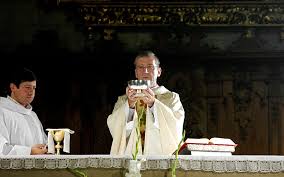The Challenge of Catholic Evangelization
Much ink has been spilled over the need for lay Catholics to bear witness to the faith, to their friends, their co-workers, and (gulp) their own families. St. Pope John Paul II declared it to be the time of the “New Evangelization.” Sherry Weddell wrote about such in Forming Intentional Disciples, and Greg Willits wrote about The New Evangelization And You.
As I look over these titles and pray about how to bear such witness, I am confounded by a very uncomfortable thought. Bearing witness is hard for a Catholic.
I’m not even talking about the cultural aspects of such. I am a convert, and before I did so, for a time, I was involved in interdenominational ministries at high school and college. I looked upon my evangelical brothers and sisters to see how it was done.
In short, (and forgive me, friends, for the oversimplification) an evangelical would engage in a conversation with another. They would share their testimony, ask about whether the person understood “The Four Spiritual Laws” or the “Romans Road.” If, during the conversation, the penitent shared that they wanted to have this “personal relationship with Jesus,” then they would pray on the spot. And then the person would be invited to that Christian’s home church, Bible Study, youth group, where he/she could get discipled and plugged in.
Forget, for a moment, about the nuances of differences in doctrine. Just focus upon what marketers call “The Buyer’s Journey.”
The Buyer’s Journey
An Evangelical talks to another person. Right then and there, a person can make (for lack of a better word) “a sale.” Boom. From then on, such a person can be invited to “upsell” to sustain that person’s new relationship with the Lord.
I don’t mean to be callous as I share these things. I use these terms to demonstrate a systematic process that has been used ever since the emergence of the Jesus Movement, which first gave root to such gimmicky approaches to the Gospel, like “The Four Spiritual Laws.”
But compare this to evangelization from a Catholic perspective.
Certainly, any Catholic can talk to a person about Christ. Certainly, any Catholic, properly trained, can learn these same approaches to the Gospel and share them with any friend, coworker or family member.
The challenge comes with the “upsell.” The challenge comes when you invite them to the mass, which, according to our faith, is the highest form of worship.
Inviting Newcomers to Church
Whereas at a non-denominational or evangelical church, the tropes are pretty self-explanatory, a Catholic liturgy (or liturgy of any denomination, for that matter) is complicated. Evangelicals, generally, have an extended set of worship songs, strung together, in a powerful and uplifting music set. Some are more like a concert, and some are more congregational-friendly, but by and large, it is crafted so that the congregants can have a time of active worship to God. There may be a collection, quick announcements, and then a sermon—a lengthy, expository, and generally entertaining and practical topic, rooted in the pastor’s personal study. A Catholic liturgy, by contrast, is a much different approach: the songs are not bunched together. There’s a lot of recited prayers. You stand up, you sit down, you do funny things with your hands, you kneel. It’s written about in the parish’s missallette or hymnal, but sometimes those are hard to follow.
A lot of ink has been spilled about making the liturgy “beautiful.” Some churches have undergone great time and expense in maintaining classic church architecture, or training a classical choir/schola to sing the propers. On the other side, some churches have undergone great time and expense in modernizing their parishes, installing large television monitors for lyrics, and undergoing a simplification of liturgical concepts for the average person to grasp (the “Rebuilt” model). For most parishes, though, the music is… okay, the homilies are… decent, and community… is but for a brief moment in the sign of peace.
The biggest issue is that of Communion. For a Catholic, Communion is the highest form of worship one could have. The problem is, a Catholic needs to be in the right state in order to receive. When children celebrate their first Communion, and it is a big deal. After which, if a person finds himself in mortal sin, they cannot receive until they have received the Sacrament of Reconciliation. To some people, they are in such a thorny mess (divorce and remarriage) that they cannot fully be reconciled until a lot of factors take place beforehand (e.g. annullments). And non-Catholics, even those who believe in the Real Presence of Christ in the Eucharist, these are all forbidden to receive the Sacrament until conversion.
The Restrictions of Liturgy
Do you see the challenge? An evangelical can invite a person to their church, and that new believer can feel a part of that community right away. A Catholic, by contrast, feels inhibited in invited a person to the Church, because not only the service itself may be foreign to a newcomer, but there will always be that uncomfortable conversation to take place, explaining that they cannot receive Communion.
Do not think for a moment that I endorse changing the liturgy, or adding little nuances to make people feel comfortable (like crossing the arms and being blessed by the host). I love the liturgy, all of it, and understand exactly why the Church has the prohibitions it does. Most parishes will simply not have the resources at hand to accomplish either side of the liturgical equation (traditional or contemporary). Most priests are heavily overworked as it is, with all the liturgies they preside over, the ministries they oversee, and the hospital visitations that they make.
The Four Types of Newcomers
But, for a person engaged in a conversation about the Catholic faith, my mind will race for clues as to which of the four scenarios that a newcomer would be in:
- A faithful, church-going Catholic, (who may need to be awakened to the reality of Christ, really living inside of him/her).
- A non-faithful Catholic, who simply needs to receive the Sacrament of Reconciliation, and then be welcomed at the Table.
- A divorced person (or one in a similar complicated living situation), who needs to wait months/years before the Church issues an annullment before the Reconciliation is complete.
- A non-Catholic, who needs to undergo the Rite of Christian Initiation for Adults, which takes about a year.
We Catholics who participate in the New Evangelization need to ask: do we have a way to minister to all peoples, especially the latter two groups, in such a way that respects all liturgical restrictions, and yet makes for new disciples?
Pope Francis’ and Jesus’ Example
As an encouragement, Pope Francis’ has modeled for us lay Catholics to be proactive in our relationships with others, irregardless of their background. But he still obeyed the liturgical laws.
More importantly, Jesus demonstrated an approach to minister to those in non-ideal backgrounds as he conversed with the Samaritan woman with the checkered history (John 4:1-42), and saved the woman caught in adultery (John 8:1-11). But in the latter case, after stating He will not condemn her, He commanded to “go and sin no more.”
My question is: Do we have a process where we could witness to others, without fear of meddling with their checkered pasts, that still honors the rubrics laid forth in the liturgy? Share your ideas in the comments.









